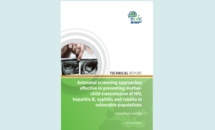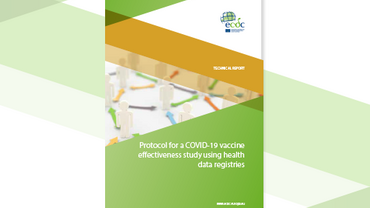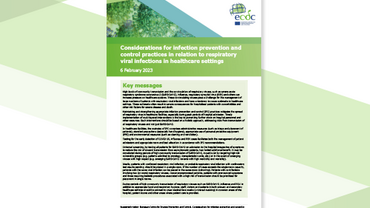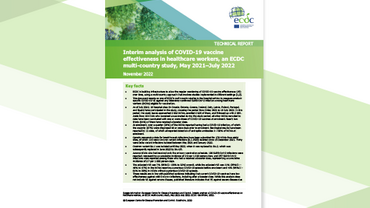Antenatal screening approaches effective in preventing MTCT of HIV, HBV, syphilis and rubella in vulnerable populations
As part of a project to map antenatal screening practices on HIV, hepatitis B, syphilis and rubella susceptibility, a survey was conducted to identify self-observed challenges in the EU/EEA Member States.
This survey found that reaching groups who are vulnerable to mother-to-child transmission (MTCT) of HIV, hepatitis B, syphilis and rubella susceptibility was considered a major obstacle to the successful prevention of mother-to-child transmission. In order to collect evidence on types of antenatal screening intervention that are effective for population groups vulnerable to MTCT, a review of the existing published literature was performed. The purpose of the review was to provide an evidence-base for a guidance on strengthening antenatal screening programmes for infections in the EU/EEA countries.
Executive summary
Transmission of infections with HIV, hepatitis B, syphilis or rubella from mother to child before and during birth as well as in infancy still occur across Europe – despite existing prevention methods. A new ECDC report outlines the cornerstones for effective antenatal screening programmes across the EU/EEA countries.
Each year, more than five million live births are recorded in the European Union. Almost as many pregnant women are screened for infections – namely for HIV, syphilis, hepatitis B and rubella susceptibility – in order to prevent possible mother-to-child transmission (MTCT). However, children are still being born with these infections in the EU/EEA. For example, 424 congenital syphilis infections and 274 HIV infections were reported in children born between 2010 and 2014.
In its evidence-based guidance, ECDC aims to help Member States to strengthen antenatal screening in the general population and in particular among vulnerable groups for MTCT. The guidance looks at which elements of a national antenatal screening programme for infections influence effectiveness, and which are the specific approaches to be used for reaching the vulnerable groups in order to increase the uptake of prenatal care and reduce mother-to-child transmission. The guidance is accompanied by two technical reports of literature reviews.
Among the main proposals for effective antenatal screening are:
- Testing for HIV, syphilis and hepatitis B during the first trimester of pregnancy.
- Repeat testing offer during the third trimester for pregnant women at increased risk of infection and/or for those who previously refused testing.
- Testing at delivery to women who had not previously been tested.
- For HIV and syphilis in particular, a universal approach should be considered for the antenatal screening, which means voluntary testing for all pregnant women with an opt-out possibility.
To improve the uptake of antenatal testing among vulnerable groups like migrant women or women at higher risk for infections due to injecting drug use or those engaging in high risk sexual practices, several options may be considered. This includes addressing communication barriers regarding language, literacy levels, or individual or cultural specifics, and improving access to antenatal care through outreach services and informal networks can help.
Why test for infections during pregnancy
Mother-to-child transmission is the most predominant mode of HIV infection in young children worldwide. Without intervention, the risk of HIV transmission from an infected mother to her child ranges from 15% to 30% during pregnancy/delivery to between 10% and 20% during breastfeeding. This risk can be reduced to 1 to 2% with a combination of appropriate antenatal interventions including anti-retroviral therapy (ART) for the mother, anti-retroviral prophylaxis for the newborn, and avoidance of breastfeeding.
Transmission of hepatitis B from mother to child is preventable in 95% of all cases through the administration of vaccine and immunoglobulin to the baby at birth. With no immunoprophylaxis, more than 90% of infants infected by their positive mothers will go on to develop chronic infection.
There is no treatment for rubella but MTCT can be prevented by ensuring that all women who plan to get pregnant are immune or have been immunised against rubella.
This report is published together with two accompanying literature reviews:
- European Centre for Disease Prevention and Control. Antenatal screening approaches effective in preventing mother-child transmission of HIV, hepatitis B, syphilis and rubella in vulnerable populations. Stockholm: ECDC; 2017.
- European Centre for Disease Prevention and Control. Effectiveness and cost-effectiveness of antenatal screening for HIV, hepatitis B, syphilis and rubella susceptibility. Stockholm: ECDC; 2017







